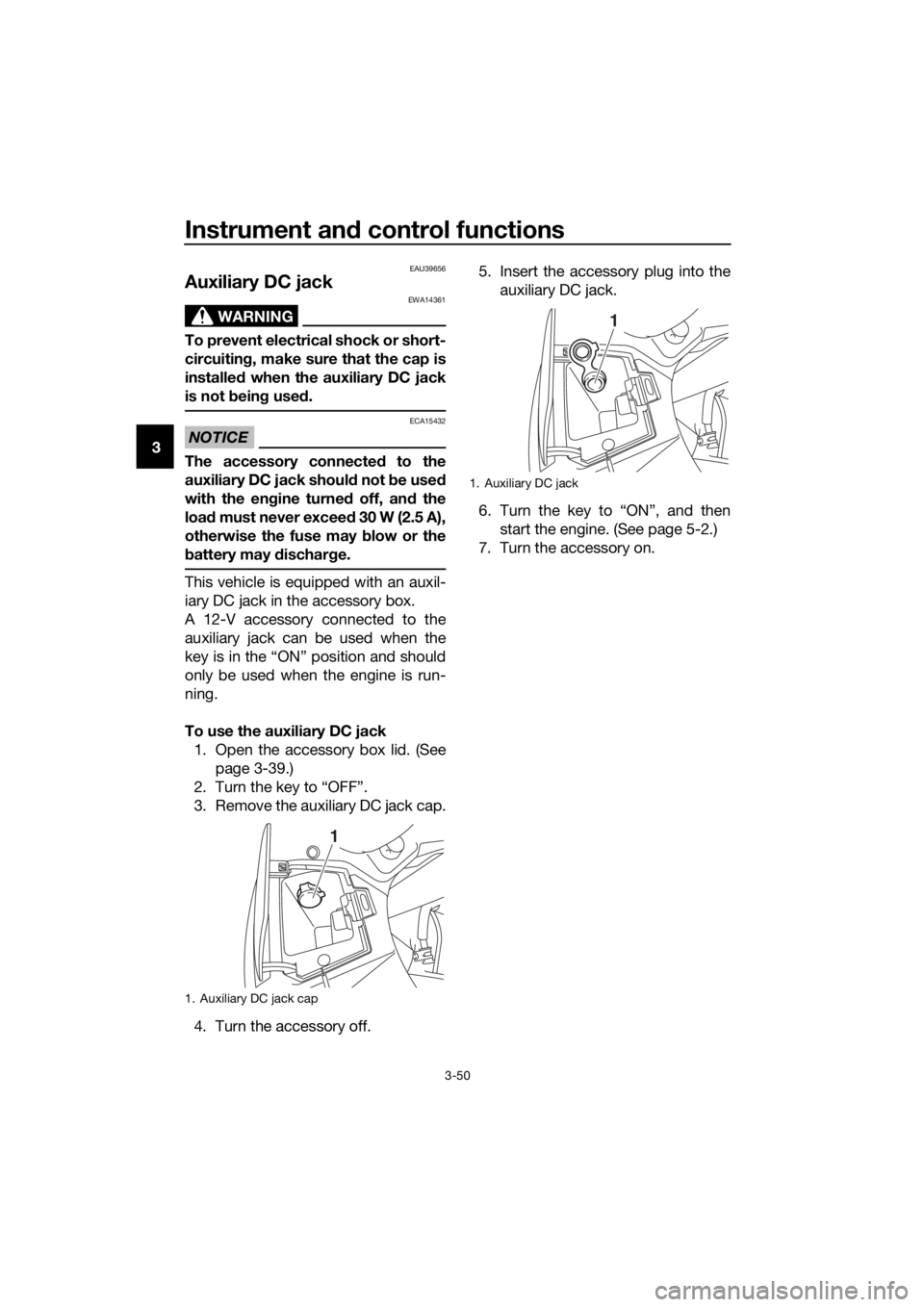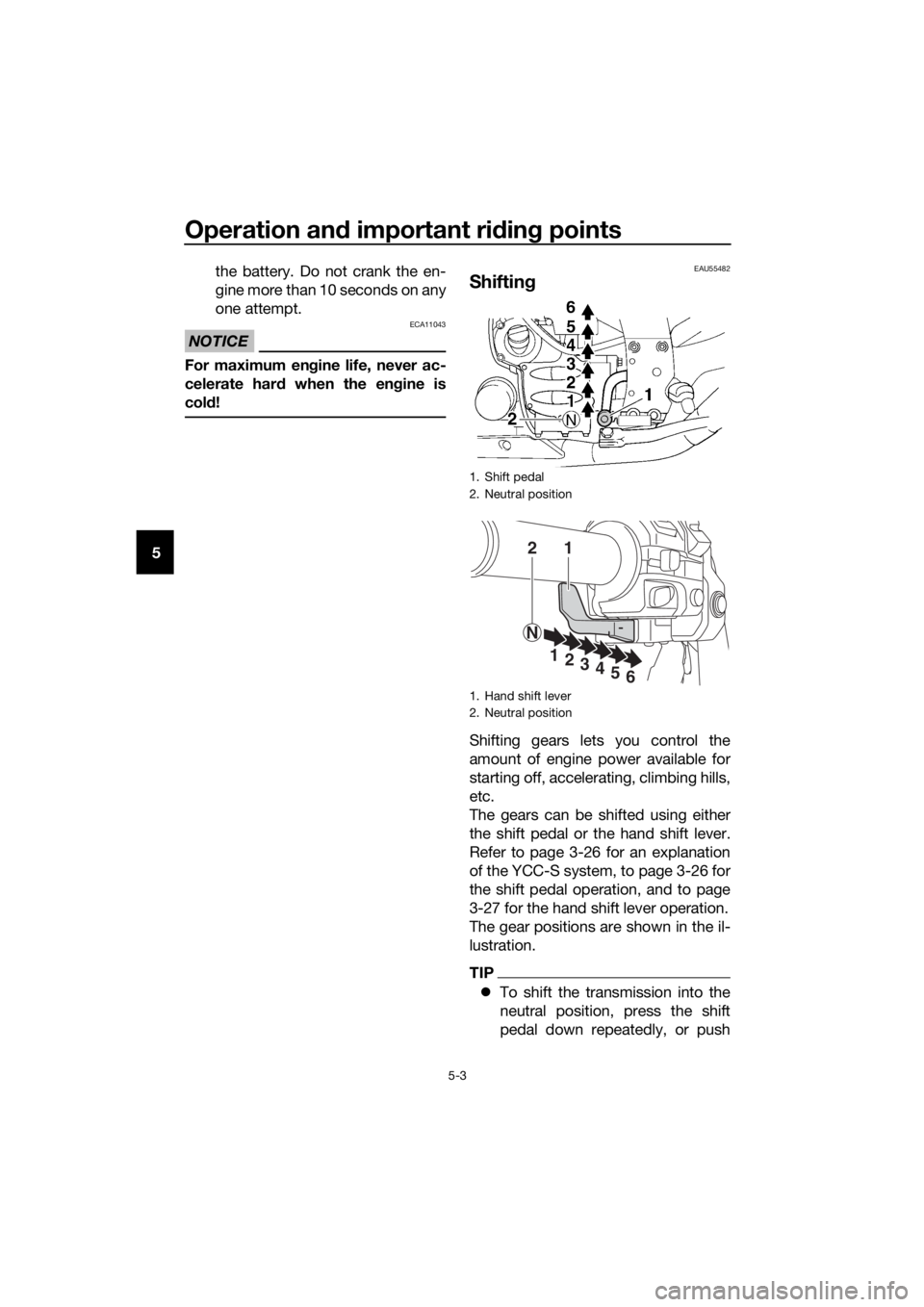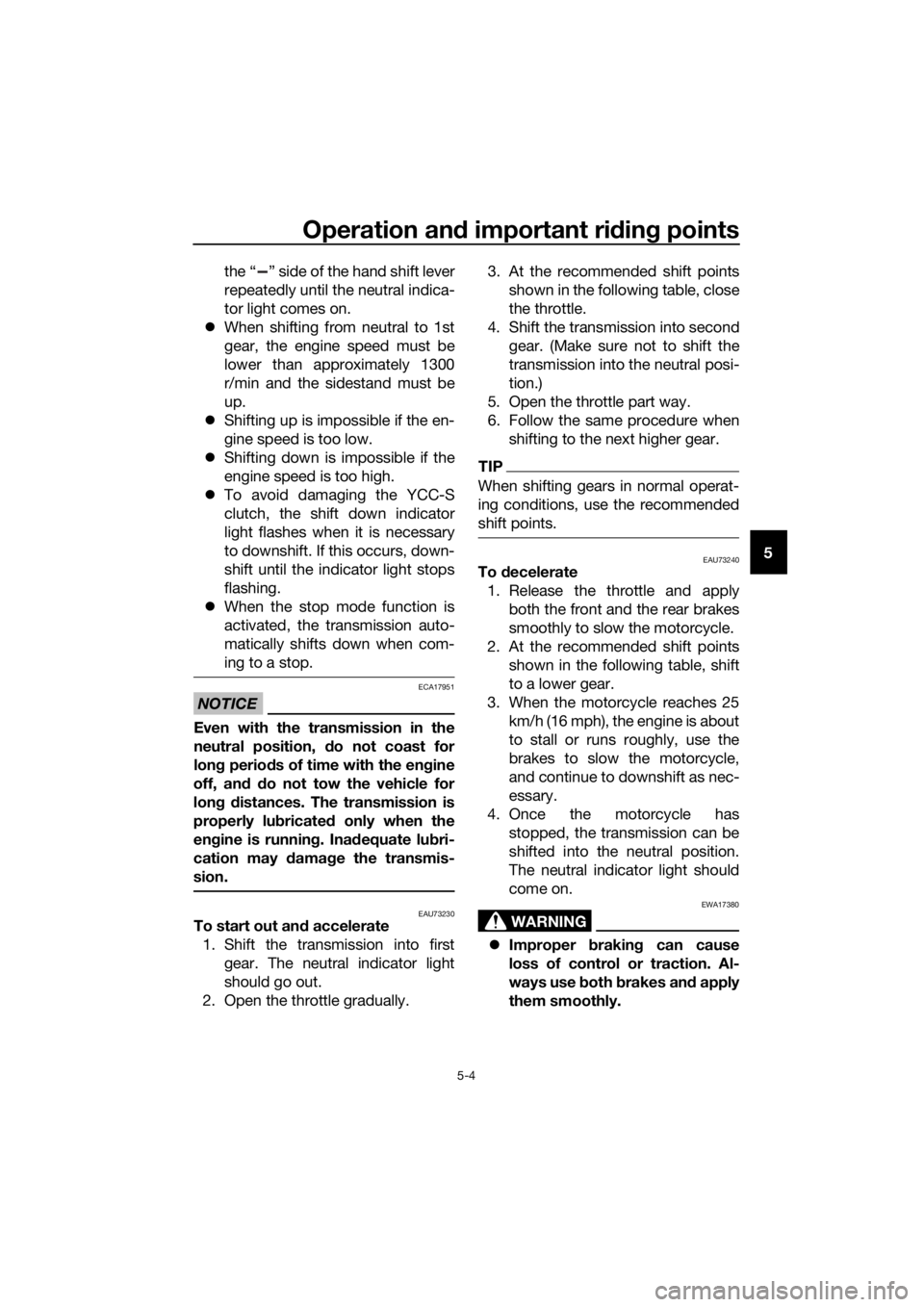2016 YAMAHA FJR1300AS engine
[x] Cancel search: enginePage 64 of 126

Instrument and control functions
3-50
3
EAU39656
Auxiliary DC jack
WARNING
EWA14361
To prevent electrical shock or short-
circuitin g, make sure that the cap is
installe d when the auxiliary DC jack
is not b eing use d.
NOTICE
ECA15432
The accessory connecte d to the
auxiliary DC jack shoul d not b e used
with the en gine turne d off, an d the
loa d must never exceed 30 W (2.5 A),
otherwise the fuse may blow or the
b attery may d ischarge.
This vehicle is equipped with an auxil-
iary DC jack in the accessory box.
A 12-V accessory connected to the
auxiliary jack can be used when the
key is in the “ON” position and should
only be used when the engine is run-
ning.
To use the auxiliary DC jack
1. Open the accessory box lid. (See page 3-39.)
2. Turn the key to “OFF”.
3. Remove the auxiliary DC jack cap.
4. Turn the accessory off. 5. Insert the accessory plug into the
auxiliary DC jack.
6. Turn the key to “ON”, and then start the engine. (See page 5-2.)
7. Turn the accessory on.
1. Auxiliary DC jack cap
1
1. Auxiliary DC jack
1
UB95E0E0.book Page 50 Friday, February 19, 2016 2:15 PM
Page 66 of 126

For your safety – pre-operation checks
4-1
4
EAU63440
Inspect your vehicle each time you use it to make sure the vehicle is in safe oper-
ating condition. Always follow the inspection and maintenance procedures and
schedules described in the Owner’s Manual.
WARNING
EWA11152
Failure to inspect or maintain the vehicle properly increases the possibility
of an acci dent or equipment d amage. Do not operate the vehicle if you fin d
any pro blem. If a pro blem cannot be correcte d b y the proce dures provi ded
in this manual, have the vehicle inspecte d b y a Yamaha dealer.
Before using this vehicle, check the following points:
ITEM CHECKSPAGE
Fuel • Check fuel level in fuel tank.
• Refuel if necessary.
• Check fuel line for leakage.
• Check fuel tank overflow hose for obstructions, cracks
or damage, and check hose connection. 3-32,
3-33
En gine oil • Check oil level in engine.
• If necessary, add recommended oil to specified level.
• Check vehicle for oil leakage. 6-11
Final gear oil • Check vehicle for oil leakage. 6-14
Coolant • Check coolant level in reservoir.
• If necessary, add recommended coolant to specified
level.
• Check cooling system for leakage. 6-15
Front brake • Check operation.
• If soft or spongy, have Yamaha dealer bleed hydraulic
system.
• Check brake pads for wear.
• Replace if necessary.
• Check fluid level in reservoir.
• If necessary, add specified brake fluid to specified level.
• Check hydraulic system for leakage. 6-23,
6-24
Rear brake • Check operation.
• If soft or spongy, have Yamaha dealer bleed hydraulic
system.
• Check brake pads for wear.
• Replace if necessary.
• Check fluid level in reservoir.
• If necessary, add specified brake fluid to specified level.
• Check hydraulic system for leakage. 6-23,
6-24
YCC-S clutch • Check operation.
• Check fluid level in reservoir.
• If necessary, add specified brake fluid to specified level.
• Check hydraulic system for leakage. 6-22,
6-24
UB95E0E0.book Page 1 Friday, February 19, 2016 2:15 PM
Page 68 of 126

Operation and important rid ing points
5-1
5
EAU15952
Read the Owner’s Manual carefully to
become familiar with all controls. If
there is a control or function you do not
understand, ask your Yamaha dealer.
WARNING
EWA10272
Failure to familiarize yourself with
the controls can lead to loss of con-
trol, which coul d cause an acci dent
or injury.
EAU73460
TIP
This model is equipped with: an inertial measurement unit (IMU)
that will stop the engine in case of
turnover. In this case, turn the key
to “OFF” and then to “ON” before
attempting to restart the engine.
Failing to do so will prevent the en-
gine from starting even though the
engine will crank when the start
switch is pushed.
an engine auto-stop system. The
engine stops automatically if left
idling for 20 minutes. In this case,
simply push the start switch to re-
start the engine.
UB95E0E0.book Page 1 Friday, February 19, 2016 2:15 PM
Page 69 of 126

Operation and important ri din g points
5-2
5
EAU55472
Startin g the eng ine
WARNING
EWA16411
Always apply the front or rear brake
while the main switch is in the “ON”
position an d the transmission is in
g ear. Otherwise, the vehicle may
su ddenly start to move when the en-
g ine is starte d, causin g loss of con-
trol an d possi bly an acci dent.
In order for the ignition circuit cut-off
system to enable starting, one of the
following conditions must be met:
The front or rear brake is applied
with the transmission in the neu-
tral position whether the sidestand
is up or down.
The front or rear brake is applied
with the transmission in gear and
the sidestand is up.
See page 3-48 for more informa-
tion.
1. Turn the key to “ON” and make sure that the start/engine stop
switch is set to “ ”.
The following warning lights and
indicator lights should come on for
a few seconds, then go off. Oil level warning light
Engine trouble warning light
Traction control system indi-
cator/warning light
Cruise control indicator lights
Electronically adjustable sus-
pension system warning light
Shift down indicator light
YCC-S system warning light
Stop mode function indicator
light
Immobilizer system indicator
light
TIP
If the stop mode function was activat-
ed when the key was turned to “OFF”
then the stop mode function is still ac-
tivated and the indicator light will re-
main on.
NOTICE
ECA11834
If a warnin g or in dicator li ght does
not come on initially when the key is
turne d to “ON”, or if a warnin g or in-
d icator li ght remains on, see pag e
3-4 for the correspon din g warnin g
an d in dicator li ght circuit check.
The ABS warning light should
come on when the key is turned to
“ON”, and then go off after travel-
ing at a speed of 10 km/h (6 mi/h)
or higher.
NOTICE
ECA17682
If the ABS warnin g li ght does not
come on an d then go off as ex-
plained above, see pa ge 3-4 for the
warnin g li ght circuit check.
2. Shift the transmission into the
neutral position. The neutral indi-
cator light should come on. If not,
ask a Yamaha dealer to check the
electrical circuit.
3. Start the engine by pushing the “ ” side of the start/engine
stop switch with the front or rear
brake applied.
If the engine fails to start, release
the start/engine stop switch, wait
a few seconds, and then try again.
Each starting attempt should be
as short as possible to preserve
UB95E0E0.book Page 2 Friday, February 19, 2016 2:15 PM
Page 70 of 126

Operation and important rid ing points
5-3
5 the battery. Do not crank the en-
gine more than 10 seconds on any
one attempt.
NOTICE
ECA11043
For maximum en
gine life, never ac-
celerate har d when the en gine is
col d!
EAU55482
Shiftin g
Shifting gears lets you control the
amount of engine power available for
starting off, accelerating, climbing hills,
etc.
The gears can be shifted using either
the shift pedal or the hand shift lever.
Refer to page 3-26 for an explanation
of the YCC-S system, to page 3-26 for
the shift pedal operation, and to page
3-27 for the hand shift lever operation.
The gear positions are shown in the il-
lustration.
TIP
To shift the transmission into the
neutral position, press the shift
pedal down repeatedly, or push
1. Shift pedal
2. Neutral position
1. Hand shift lever
2. Neutral position
12
N
1
23456
UB95E0E0.book Page 3 Friday, February 19, 2016 2:15 PM
Page 71 of 126

Operation and important ri din g points
5-4
5
the “ ” side of the hand shift lever
repeatedly until the neutral indica-
tor light comes on.
When shifting from neutral to 1st
gear, the engine speed must be
lower than approximately 1300
r/min and the sidestand must be
up.
Shifting up is impossible if the en-
gine speed is too low.
Shifting down is impossible if the
engine speed is too high.
To avoid damaging the YCC-S
clutch, the shift down indicator
light flashes when it is necessary
to downshift. If this occurs, down-
shift until the indicator light stops
flashing.
When the stop mode function is
activated, the transmission auto-
matically shifts down when com-
ing to a stop.
NOTICE
ECA17951
Even with the transmission in the
neutral position, do not coast for
lon g period s of time with the en gine
off, an d d o not tow the vehicle for
lon g d istances. The transmission is
properly lu bricate d only when the
en gine is runnin g. Ina dequate lu bri-
cation may d amage the transmis-
sion.
EAU73230To start out an d accelerate
1. Shift the transmission into first gear. The neutral indicator light
should go out.
2. Open the throttle gradually. 3. At the recommended shift points
shown in the following table, close
the throttle.
4. Shift the transmission into second gear. (Make sure not to shift the
transmission into the neutral posi-
tion.)
5. Open the throttle part way.
6. Follow the same procedure when shifting to the next higher gear.
TIP
When shifting gears in normal operat-
ing conditions, use the recommended
shift points.
EAU73240To decelerate
1. Release the throttle and apply both the front and the rear brakes
smoothly to slow the motorcycle.
2. At the recommended shift points shown in the following table, shift
to a lower gear.
3. When the motorcycle reaches 25 km/h (16 mph), the engine is about
to stall or runs roughly, use the
brakes to slow the motorcycle,
and continue to downshift as nec-
essary.
4. Once the motorcycle has stopped, the transmission can be
shifted into the neutral position.
The neutral indicator light should
come on.
WARNING
EWA17380
Improper brakin g can cause
loss of control or traction. Al-
ways use b oth brakes an d apply
them smoothly.
UB95E0E0.book Page 4 Friday, February 19, 2016 2:15 PM
Page 72 of 126

Operation and important rid ing points
5-5
5
Make sure that the motorcycle
and the en gine have sufficiently
slowe d b efore shiftin g to a low-
er gear. En gag in g a lower gear
when the vehicle or en gine
speed is too hi gh coul d make
the rear wheel lose traction or
the en gine to over-rev. This
coul d cause loss of control, an
acci dent an d injury. It coul d also
cause en gine or drive train dam-
a g e.
EAU64150Recommen ded shift points
The recommended shift points during
acceleration and deceleration are
shown in the table below.
EAU16811
Tips for re ducin g fuel con-
sumption
Fuel consumption depends largely on
your riding style. Consider the follow-
ing tips to reduce fuel consumption:
Shift up swiftly, and avoid high en-
gine speeds during acceleration.
Do not rev the engine while shift-
ing down, and avoid high engine
speeds with no load on the en-
gine.
Turn the engine off instead of let-
ting it idle for an extended length
of time (e.g., in traffic jams, at traf-
fic lights or at railroad crossings).
Shift up points:
1st → 2nd: 20 km/h (12 mph)
2nd → 3rd: 30 km/h (19 mph)
3rd → 4th: 40 km/h (25 mph)
4th → 5th: 50 km/h (31 mph)
5th → 6th: 60 km/h (37 mph)
Shift down points:
6th → 5th: 45 km/h (28 mph)
5th → 4th: 35 km/h (22 mph)
4th → 3rd: 25 km/h (16 mph)
UB95E0E0.book Page 5 Friday, February 19, 2016 2:15 PM
Page 73 of 126

Operation and important ri din g points
5-6
5
EAU16842
En gine break-in
There is never a more important period
in the life of your engine than the period
between 0 and 1600 km (1000 mi). For
this reason, you should read the fol-
lowing material carefully.
Since the engine is brand new, do not
put an excessive load on it for the first
1600 km (1000 mi). The various parts in
the engine wear and polish themselves
to the correct operating clearances.
During this period, prolonged full-throt-
tle operation or any condition that
might result in engine overheating
must be avoided.
EAU17124
0–1000 km (0–600 mi)
Avoid prolonged operation above 4500
r/min. NOTICE: After 1000 km (600
mi) of operation, the en gine oil an d
final gear oil must be chan ged , an d
the oil filter cartri dge or element re-
place d.
[ECA10333]
1000–1600 km (600–1000 mi)
Avoid prolonged operation above 5400
r/min.
1600 km (1000 mi) an d b eyon d
The vehicle can now be operated nor-
mally.
NOTICE
ECA10311
Keep the en gine spee d out of
the tachometer red zone.
If any en gine trou ble shoul d oc-
cur durin g the en gine break-in
period , imme diately have a
Yamaha dealer check the vehi-
cle.
UB95E0E0.book Page 6 Friday, February 19, 2016 2:15 PM